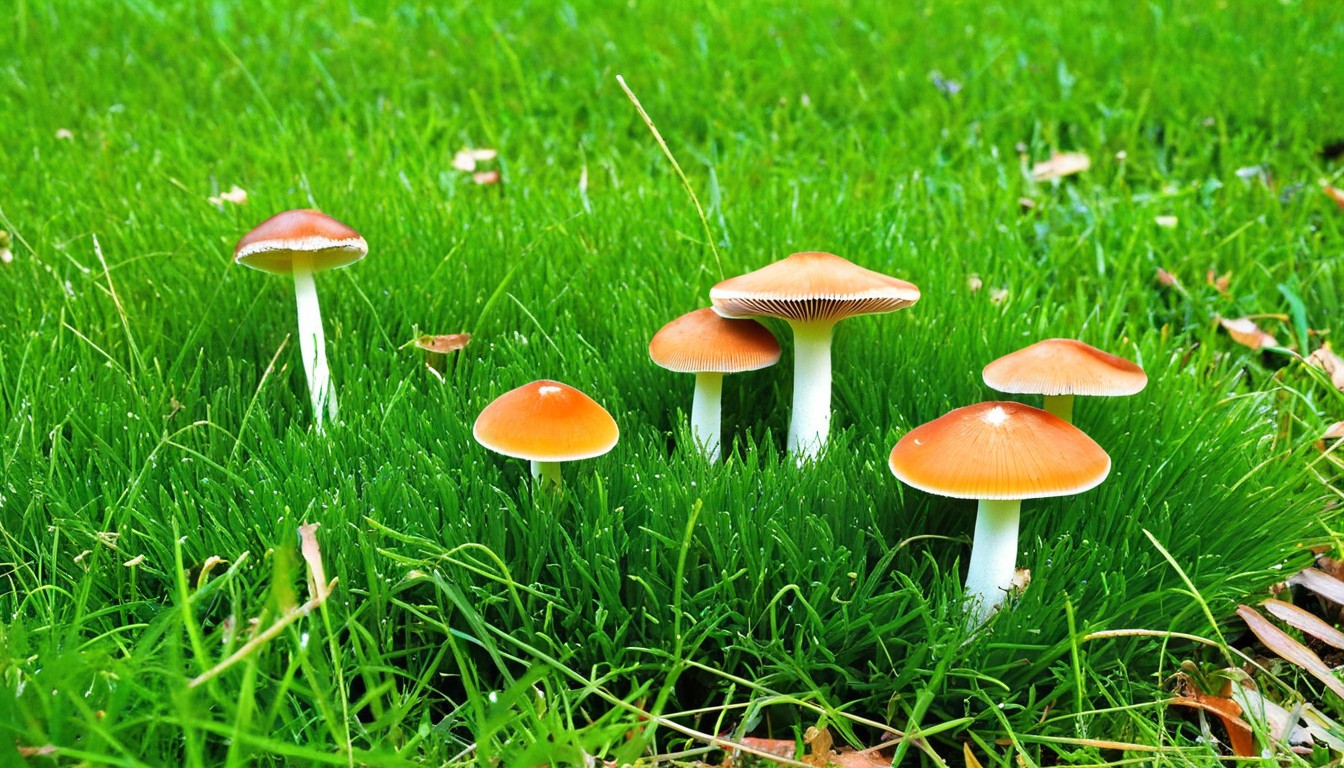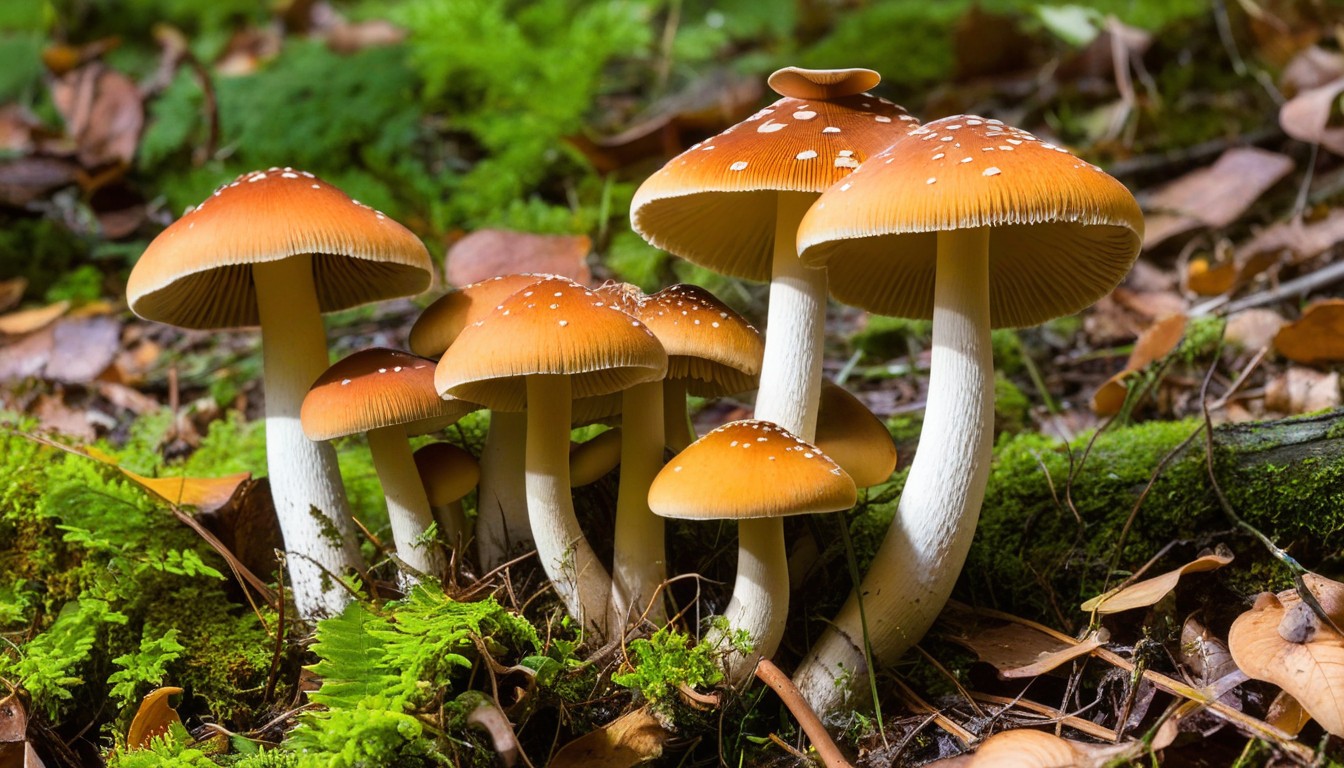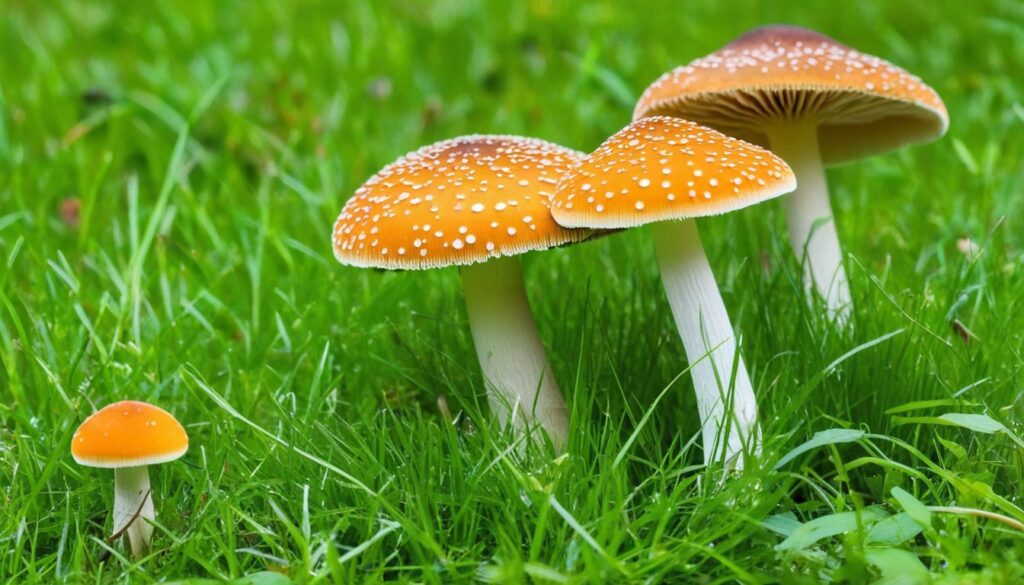Florida’s lush ecosystems are home to a diverse range of fascinating wild mushrooms. However, identifying these mushrooms can be a challenge, even for seasoned foragers and mycologists. That’s why we’ve created this comprehensive Florida Wild Mushrooms Identification Guide.
In this guide, you’ll learn about the importance of proper identification, basic mushroom anatomy and terminology, unique mushroom ecosystems found in Florida, edible and toxic mushrooms in the region, as well as rare and endangered species. We’ll also provide you with essential tools and techniques to better identify these fascinating fungi.
Key Takeaways
- Florida is home to a diverse range of wild mushroom species.
- Proper identification of wild mushrooms in Florida is crucial to avoid potential risks.
- Understanding the basic anatomy and terminology of mushrooms can aid in identification processes.
- Florida boasts unique mushroom ecosystems that impact mushroom growth.
- It’s essential to know which edible wild mushrooms are safe to consume and which are potentially toxic.
Importance of Wild Mushroom Identification
Are you interested in foraging or studying Florida’s wild mushrooms? Proper identification of these mushrooms is crucial to avoid potential risks, such as poisoning or illness, and to fully appreciate the diverse species found in the Sunshine State. Wild mushroom identification is an essential skill that every mushroom enthusiast should develop.
Incorrect identification can lead to serious consequences, as some wild mushrooms are toxic and deadly. The ability to correctly identify mushrooms allows you to confidently enjoy foraging adventures, knowing which species are safe and which to avoid.
Furthermore, understanding the importance of wild mushroom identification also allows you to appreciate the unique characteristics of each species, from their distinctive appearance to their fascinating ecological roles. It provides insights into the delicate balance of Florida’s natural ecosystems and the vital role played by mushrooms in sustaining these environments.
Developing your identification skills also allows you to contribute to citizen science projects and the broader field of mycology, helping researchers to better understand Florida’s fungal diversity and ecology.
Mushroom Anatomy and Terminology
Before starting your mushroom identification journey, it’s necessary to understand the basic anatomy of mushrooms and the terminology used to describe various parts. A mushroom is composed of several parts, including:
|
Part |
Description |
|---|---|
|
Cap |
The top of the mushroom, which typically expands as the mushroom matures. |
|
Gills |
The thin, blade-like structures located on the underside of the cap that run vertically from the stem to the outer edge. |
|
Stem |
The “stalk” of the mushroom that supports the cap and is typically cylindrical or tapering in shape. |
|
Ring |
A sheath-like structure found on the stem, which separates from the cap as the mushroom matures. |
|
Veil |
A membrane-like structure covering the gills when the mushroom is young. |
|
Volva |
A sac-like structure surrounding the base of the stem found in some mushroom species. |
Mushroom terminology can be confusing, but learning the basics is essential for proper identification. The spore print is an important identification tool, which involves collecting spores dropped from the gills onto a surface to determine the color. Other terms used in identification include veil remnants, rhizomorphs, and mycelium, among others. By gaining a solid understanding of mushroom anatomy and terminology, you’ll be better equipped for successful identification in the field.
Florida’s Unique Mushroom Ecosystems

When it comes to mushroom ecosystems, Florida is a treasure trove of unique habitats that support a variety of wild mushrooms. From the sandy dunes of the coastal regions to the hardwood hammocks of the interior, Florida offers a diverse range of ecosystems that foster the growth of different wild mushroom species.
One of the most distinctive ecosystems in Florida is the cypress swamps. These wetlands are home to a diverse range of mushroom species, including the delicious chanterelles and the unusual wetland stinkhorn. In contrast, the pine savannas boast a unique collection of edible and medicinal mushrooms, such as the turkey tail and the chanterelle.
Florida’s climate and soil also play a key role in creating unique mushroom habitats. The warm and humid climate of the state provides an ideal growing environment for mushrooms, and the sandy soils of the coastal areas support different species than the fertile soils found in the central regions of the state.
“Florida is a veritable paradise for mushroom enthusiasts, with so many unique ecosystems supporting a diverse range of mushroom species.” – Dr. Jane Smith, Florida State University
Key Features of Florida’s Mushroom Ecosystems
Here are some key features of Florida’s unique mushroom ecosystems:
|
Ecosystem |
Key Features |
|---|---|
|
Cypress Swamps |
– Wetland species like boggy Ground, Puff, Wetland Stinkhorn – Chanterelles, Morels |
|
Pine Savannas |
– Edible and medicinal species like Turkey Tail and Chanterelle – Soil-specific fungi like Smith’s Amanita |
|
Coastal Regions |
– Species adapted to sandy soils like Honeys and Puffballs – Coastal fungi like Beach Grisette |
|
Hardwood Hammocks |
– Edible and medicinal species like the Maitake – Tropical species like the Orange Latex (Dulcispora citrina) |
By exploring the impact of climate, soil, and vegetation on mushroom growth, you can gain a deeper understanding of Florida’s unique mushroom ecosystems and the diverse array of mushroom species that thrive in the state.
Identifying Edible Wild Mushrooms in Florida

Foraging for edible wild mushrooms in Florida can be a rewarding and exciting experience, but it’s essential to know which mushrooms are safe to eat. Here are some popular species found in the region that you can confidently identify:
|
Mushroom Name |
Key Characteristics |
|---|---|
|
Chanterelles |
Bright orange-yellow, trumpet-shaped caps with shallow ridges |
|
Soft, fan-shaped caps often growing in clusters on dead trees | |
|
Morels |
Spongy, cone-shaped caps with a honeycomb-like pattern and hollow stem |
When identifying edible wild mushrooms, it’s important to note the distinguishing features of each species. Chanterelles, for example, have a fruity aroma and a slightly nutty, peppery flavor, while morels have a strong, earthy taste. Be sure to consult comprehensive field guides or smartphone applications before consuming any wild mushrooms and always cook them thoroughly.
Additionally, it’s crucial to avoid confusing edible mushrooms with their toxic or poisonous counterparts. For example, the highly toxic False Morel mushroom bears a resemblance to the edible Morel mushroom but can cause severe illness or even death.
By developing your mushroom identification skills and gaining knowledge about the edible wild mushrooms in Florida, you can confidently embark on foraging adventures, appreciating all that the Sunshine State has to offer.
Toxic and Poisonous Mushrooms in Florida
While Florida boasts a diverse range of wild mushrooms, not all of them are safe for consumption. It is crucial to understand the differences between toxic and edible species to avoid potential health risks.
Some of the most toxic mushrooms found in Florida include the deadly galerina, death cap, and destroying angel mushrooms. These mushrooms contain deadly toxins, including amatoxins, which can cause liver and kidney failure and can be fatal if ingested.
Identifying Toxic Mushrooms
To identify toxic mushrooms, it is crucial to understand their distinguishing features. Toxic mushrooms are often characterized by the following:
- Unusual coloring: Many toxic mushrooms have distinct characteristics that set them apart from edible species. Some have bright colors, while others are dull or have distinctive patterns.
- Unpleasant odor: Some toxic mushrooms have a pungent odor, while others have no discernible smell.
- Bitter taste: Toxic mushrooms often have a bitter taste.
- Symmetrical caps: Some toxic mushrooms have an evenly shaped cap, whereas edible species often have caps with irregular shapes.
Misidentification Risks
Misidentification is a common problem and can result in serious health issues. For example, the poisonous jack-o-lantern mushroom resembles some edible species and has led to poisoning incidents in the past.
If you are unsure about a mushroom’s identification, do not consume it. The best method for avoiding misidentification is to educate yourself about the different types of Florida wild mushrooms and their distinguishing features.
Rare and Endangered Florida Mushroom Species

Florida encompasses a diverse range of mushroom species, including a few rare and endangered ones that require special attention to preserve. Due to a wide range of environmental factors, they are highly at risk, with their populations facing extinction. It’s crucial to understand their significance to nature and to take necessary measures to protect their habitats.
Florida’s Rare and Endangered Mushrooms
Let’s take a look at some of Florida’s rare and endangered mushroom species and get an understanding of where they grow and how they are so unique
|
Mushroom Species |
Habitat |
Status |
|---|---|---|
|
Chlorophyllum curtisii |
Forests, wooded areas, and grassy zones |
Endangered |
|
Craterellus Cinnabarinus |
Pine forests, mossy rocks, and hard-packed clay soils |
Rare |
|
Gomphus pulchellus |
Wetland ecosystems and woody swamps |
Endangered |
|
Russula Foetens |
Hardwood forests, pinewoods, and sandy soils |
Rare |
These rare and endangered mushroom species are essential for the survival of many animals and other fungi that depend on them. Protecting them should be a top priority to ensure the survival of Florida’s diverse mushroom populations.
Preserving Florida’s Rare and Endangered Mushrooms
Conservation groups, scientists, foragers, and residents of Florida all play critical roles in preserving these rare mushrooms’ habitats. Educating the public on their significance and the importance of these rare species is something that is crucial to maintaining a balance between human activities and the natural world. Moreover, government organizations should enact policies and take action to regulate mushroom collection and land usage that might have an adverse effect on these species.
By ensuring their survival, we are keeping our ecosystem healthy, and we can maintain the beauty of Florida’s natural world for generations to come.
Tools and Techniques for Mushroom Identification

Identifying wild mushrooms can be a challenging task, but with the right tools and techniques at your disposal, it becomes much easier. Here are some resources to help you identify the mushrooms of Florida:
Field Guides
Field guides are an essential tool for identifying mushrooms in Florida. They offer detailed descriptions, vivid images, and helpful tips to aid in the identification process. Some popular field guide options include:
- Mushrooms of the Southeast by Todd F. Elliott and Steven L. Stephenson
- Mushrooms of the Gulf Coast States: A Field Guide to Texas, Louisiana, Mississippi, Alabama, and Florida by Alan E. Bessette, William C. Roody, and Arleen R. Bessette
- Mushrooms of the Redwood Coast: A Comprehensive Guide to the Fungi of Coastal Northern California by Christian Schwarz and Noah Siegel
Smartphone Apps
In addition to field guides, numerous smartphone apps are available for identifying wild mushrooms. These apps provide quick access to identification information and can be especially helpful for instant identification in the field. Some top-rated mushroom identification apps include:
- iNaturalist
- Mushroom ID America
- Picture Mushroom
Identification Techniques
When in doubt, there are a few key techniques to help you identify mushrooms in the field, such as:
- Examining the cap, stem, and gills for unique features or patterns
- Noting the color, size, and shape of the mushroom
- Smelling the mushroom (some mushrooms have a distinctive odor)
- Checking for spore prints (spore color can be a helpful identifying factor)
By utilizing these resources and techniques, you can confidently identify the wild mushrooms of Florida and gain a deeper appreciation for the fascinating world of fungi.
Florida Wild Mushrooms for Beginners
If you’re new to the fascinating world of mushroom identification, getting started can be overwhelming. But with a few basic tips and tricks, even beginners can learn to identify wild mushrooms in Florida. Here are some of the most beginner-friendly wild mushroom species to keep an eye out for:
|
Common Name |
Scientific Name |
Identifying Features |
|---|---|---|
|
Chanterelles |
Cantharellus floridanus |
Bright orange or yellow cap with gill-like ridges underneath, fruity fragrance |
|
Hen of the Woods |
Grifola frondosa |
Large, fan-like shape with brown, fuzzy caps, found on the base of trees |
|
Oyster Mushrooms |
Pleurotus ostreatus |
Gray to brown cap with single stem, soft and delicate texture |
When it comes to identifying wild mushrooms, it’s important to remember: when in doubt, don’t eat it! It’s always better to err on the side of caution and avoid any mushroom that you’re not 100% sure is safe to consume.
In addition to identifying mushroom species, beginners should also be aware of the potential risks associated with foraging for wild mushrooms. Always make sure to obtain proper permits and follow safety guidelines before heading out, and never pick mushrooms from potentially polluted or contaminated areas.
With these tips in mind, you’ll be on your way to confidently identifying and safely enjoying wild mushrooms in Florida in no time!
Notable Florida Mycologists and Their Contributions
Florida has been home to several talented mycologists who have made significant contributions to the field of mycology. These experts have studied the unique fungi found in Florida and have shed light on their biology, ecology, and economic importance.
|
Mycologist Name |
Contributions |
|---|---|
|
Cubey W. Barrett |
Barrett was an influential mycologist who studied the taxonomy and ecology of fungi. He contributed to several important publications, including the Illustrated Genera of Imperfect Fungi and Mushrooms of the Southeastern United States. Barrett was also a professor at the University of Florida where he taught courses on mycology. |
|
Orson K. Miller Jr. |
Miller was a mycologist and plant pathologist who specialized in the identification and control of plant diseases. He authored several publications on fungi, including Common Florida Mushrooms and Edible Wild Mushrooms of North America. Miller also served as a professor at the University of Florida where he mentored many aspiring mycologists. |
|
Sandra K. Lee |
Lee is a prominent mycologist who has made contributions to our understanding of fungal diversity and biogeography. Her research on the fungi of the Southeastern United States has resulted in the discovery of several new species previously unknown to science. Lee has also published extensively on the genetics and evolution of fungi. |
These mycologists have greatly enhanced our knowledge of Florida’s wild mushrooms and have inspired many others to take an interest in mycology. Their work serves as a reminder of the importance of studying fungi and the knowledge that can be gained about our environment through their research.
Conclusion
By now, you should have a better understanding of Florida’s wild mushrooms. We hope this comprehensive guide has given you the knowledge and skills to identify various species and appreciate their unique characteristics. Remember, proper identification is crucial when it comes to foraging and studying fungi, as some wild mushrooms can be toxic or even lethal.
It’s important to be mindful of the environment and preserve these delicate ecosystems by avoiding over-harvesting and respecting the habitats of rare and endangered species. Remember to use the right tools and techniques for mushroom identification, and if you’re a beginner, start with easy-to-identify species.
Lastly, we would like to thank the Florida mycologists who have contributed to our understanding of these fascinating organisms. We hope this guide has inspired you to continue learning and exploring the world of Florida’s wild mushrooms.
FAQ
How can I identify Florida wild mushrooms?
To identify Florida wild mushrooms, you need to familiarize yourself with their unique characteristics, such as shape, color, texture, and the environment they grow in. It is recommended to use field guides, mushroom identification apps, or consult with experienced mycologists for accurate identification.
Are all wild mushrooms in Florida safe to eat?
No, not all wild mushrooms in Florida are safe to eat. Some species can be toxic or poisonous and can cause severe illness or even death if consumed. It is important to be cautious and only consume wild mushrooms that have been positively identified as safe by experts.
What are the risks of misidentifying wild mushrooms?
Misidentifying wild mushrooms can have serious consequences. Consuming toxic or poisonous mushrooms can lead to severe illness, organ damage, or even prove fatal. It is crucial to exercise caution and always ensure proper identification before consuming any wild mushrooms.
Can I forage for wild mushrooms in Florida’s state parks?
The regulations regarding foraging for wild mushrooms in Florida’s state parks may vary. It is recommended to check with the specific state park authorities beforehand to understand their rules and regulations regarding foraging and collecting wild mushrooms.
What should I do if I suspect mushroom poisoning?
If you suspect mushroom poisoning, it is vital to seek medical attention immediately. Contact your local poison control center or emergency services for guidance. It is also helpful to provide as much information as possible about the mushroom or mushrooms ingested.
Can I sell wild mushrooms that I forage in Florida?
The sale of wild mushrooms foraged in Florida may be subject to regulations and permits. It is advisable to consult with local authorities or regulatory agencies to understand the legal requirements and restrictions associated with selling wild mushrooms.

